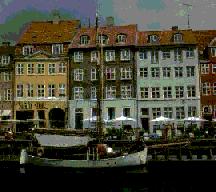 The
history of the Danish language may be divided into three main periods:
Old Danish (800-1100), Middle Danish (1100-1500), and Modern Danish (from
1500). Examples of Old Danish are preserved in numerous runic inscriptions,
including the most famous and the earliest found: ek HlewagastiR HoltijaR
horna tawido (I, Hlewagast, son of Holtijas, made a horn). Early
Middle Danish is represented sparingly in proper names occurring in 12th-century
Latin documents and more fully in early Danish laws. These sources show
that no common language existed at that time, but that three "provincial
languages" were in use: those of Scania (then a part of Denmark), Zealand,
and Jutland. Middle Danish underwent important changes, such as the leveling
of inflections and the simplification of grammar, and absorbed many loan
words, especially from Low German. Zealandic,
as used in the government offices, became the norm for a common language.
The
history of the Danish language may be divided into three main periods:
Old Danish (800-1100), Middle Danish (1100-1500), and Modern Danish (from
1500). Examples of Old Danish are preserved in numerous runic inscriptions,
including the most famous and the earliest found: ek HlewagastiR HoltijaR
horna tawido (I, Hlewagast, son of Holtijas, made a horn). Early
Middle Danish is represented sparingly in proper names occurring in 12th-century
Latin documents and more fully in early Danish laws. These sources show
that no common language existed at that time, but that three "provincial
languages" were in use: those of Scania (then a part of Denmark), Zealand,
and Jutland. Middle Danish underwent important changes, such as the leveling
of inflections and the simplification of grammar, and absorbed many loan
words, especially from Low German. Zealandic,
as used in the government offices, became the norm for a common language.
By about 1500, the chief characteristics of Danish had evolved, and it began to be used as a national language. The printing and publishing activities that occurred during the Reformation led to a considerable transformation of the medieval orthography and contributed markedly to the development of a literary vocabulary. A geographical expansion of Danish took place when it became the official written language of Norway, which was then united with Denmark. Under the influence of humanism, Latin was used extensively in literary writing from about 1550 to about 1700. During the last half of the 17th century, German was spoken at the royal court, and many German words entered the Danish language; most of them were later discarded. Danish had virtually completed its grammatical development by the beginning of the 18th century, and it became a significant cultural and literary language, especially through the work of the poet, playwright, and historian Ludvig Holberg.
In the 19th and 20th centuries, fewer dialects were spoken, the interaction between spoken and written language increased, and the vocabulary expanded through the assimilation of German, French, and English words, including many technical terms. An authorized standard orthography, with subsequent revisions, has been in effect since 1871. Through a spelling reform adopted in 1948 the capitalization of nouns was abolished, and the letter aa was replaced by å, which brought Danish closer to Norwegian and Swedish.
The most notable features of today's Danish are: in phonetics - usage
of the glottal stop consonant sound, and of softened consonants b,
d, g; in morphology - the definite article as in Western Germanic
languages. These are unique in Danish and distinguish it from Swedish,
Icelandic and other Scandinavian tongues.